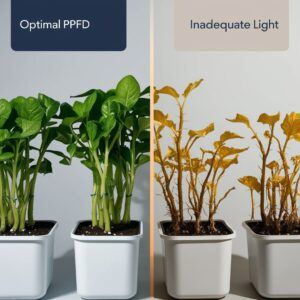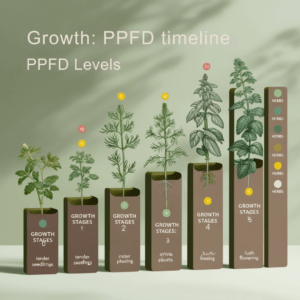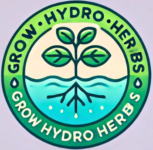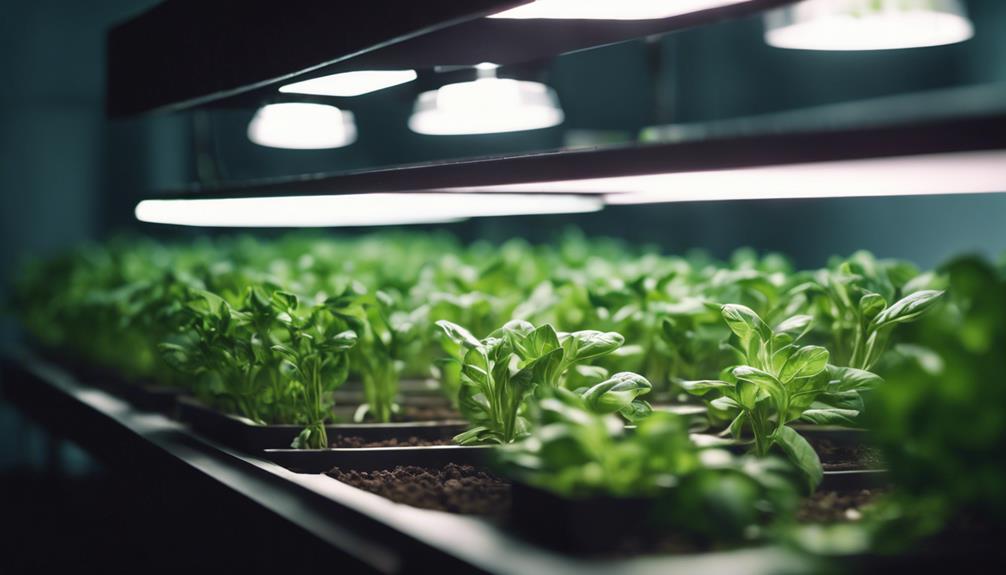What is Photosynthetic Photon Flux Density (PPFD) in Hydroponics?
Photosynthetic Photon Flux Density (PPFD) is a metric that tells you how many photons of light are hitting a square meter of your garden, every second. This is paramount for understanding light intensity in hydroponics. These photons are what plants use to perform photosynthesis, the process through which they convert light into energy.

Measured in micromoles per square meter per second (µmol/m²/s), PPFD isn’t just a random number. It’s a crucial indicator for plant development. Higher PPFD values generally mean that plants are getting more light, translating to more potential energy for growth.
In hydroponic systems, light is the primary energy source for plants, replacing sunlight with artificial grow lights. This makes PPFD even more critical in these setups. The right PPFD levels can significantly affect how well your plants grow, how fast they mature, and the overall yield you can expect.
It’s essential to remember that PPFD isn’t uniform across an entire grow area. Factors like the type of light source, its height above the plants, and even the shape of the leaves can create variations. Understanding these nuances can help you set up a more efficient and productive garden.
Whether you’re growing herbs, vegetables, or ornamental plants, knowing your PPFD can help optimize growth stages by ensuring you’re delivering the right amount of light. This directly affects photosynthesis rates, leading to healthier plants and better yields.
GrowHydroHerbs TLDR
- PPFD is crucial for plant growth: It measures the light intensity your plants receive, directly impacting their photosynthesis and overall health in hydroponic systems.
- Adjust PPFD for growth stages: Different stages like seedlings, vegetative growth, and flowering require specific PPFD levels to thrive and maximize yields.
- Regular measurement is essential: Using light meters to monitor PPFD ensures your plants get optimal light, promoting uniform growth and preventing issues.
- Balance light intensity and duration: Combining appropriate PPFD levels with correct light durations optimizes the Daily Light Integral (DLI) for healthy plant development.
- Choose the right grow lights: Selecting suitable lighting based on PPFD output, spectrum, and efficiency enhances growth while avoiding common lighting mistakes.
The Importance of PPFD in Hydroponic Systems
PPFD directly influences how fast your plants grow. Think of it as the fuel for the plant’s engine. Without adequate PPFD, your plants simply won’t get the energy they need to thrive.

In a hydroponic setup, where plants rely entirely on artificial light, PPFD becomes even more crucial. Insufficient light can slow down growth, while too much can cause light stress, leading to leaf burn and inhibited development.
Effective PPFD levels are essential for maximizing your herbs’ potential. For instance, basil and mint have relatively high PPFD needs compared to other herbs. Knowing this can guide you in selecting the right light intensity and positioning for your specific crops.
PPFD isn’t just about light quantity; it’s also about ensuring the right light quality. Balanced and consistent PPFD levels work in tandem with other factors like nutrient availability and water quality to create an environment where plants can flourish.
For anyone venturing into hydroponic herb gardening, keeping a close eye on PPFD can give you a substantial edge. It’s a factor that, when managed well, can spell the difference between a mediocre harvest and an abundant one. Balancing PPFD with other growth factors like humidity and temperature is key to achieving the healthiest plants and highest yields.
Measuring PPFD in a Hydroponic Setup
To get your PPFD levels right, you need the right tools. Start with a quality light meter or a sensor specifically designed for measuring PPFD. These tools provide you with accurate readings in micromoles per square meter per second (µmol/m²/s), offering you a clear picture of light intensity across your growing area.
Correct placement of these sensors is crucial. Position them at the canopy level of your plants to get the most accurate readings. If your garden has plants of varying heights, you might need multiple measurements to ensure even light distribution. Moving the sensor around also helps in identifying any light hotspots or shadows, allowing you to make adjustments accordingly.
Understanding the PPFD values in different parts of your hydroponic system can be a game-changer. High readings might indicate areas that are getting too much light, risking light stress. Low readings can show where plants might be struggling to get enough light for optimal growth. Balancing these values ensures more uniform growth and helps you adjust light fixtures and their positions appropriately.
Once you have your PPFD measurements, use the data to fine-tune your lighting setup. Adjusting the height of your lights can help in achieving the desired PPFD levels. Remember, the goal is to provide consistent and appropriate light for your plants’ growth stages, maximizing their photosynthetic efficiency.
Regularly monitoring and adjusting your PPFD can prevent issues before they become problems, keeping your hydroponic garden in top shape.
Optimal PPFD Levels for Different Herb Growth Stages

Every stage of your herb’s growth needs different light intensities to thrive. Seedlings, for instance, are more delicate. They require lower PPFD levels, usually between 100-300 µmol/m²/s. This range helps them establish roots without being overwhelmed by too much light.
Once your herbs move into the vegetative growth phase, they can handle more light. Increasing PPFD levels to around 300–600 µmol/m²/s gives the plants the energy they need to develop robustly. This stage is crucial as it’s when your herbs will set their foundation for a healthy yield.
During the flowering or harvest stage, specific PPFD requirements can vary depending on the herb. Generally, most herbs do well with PPFD levels in the range of 600-900 µmol/m²/s. This higher light intensity helps in maximizing yield and quality.
Balancing these different PPFD levels throughout your plant’s life cycle is essential. Knowing when to ramp up or dial back the light can mean the difference between a moderate harvest and a bountiful one. Tracking these changes can also help you adjust other factors like nutrient levels and watering schedules to match your plants’ needs.
Keeping a consistent PPFD that matches each stage of growth ensures that your herbs get the right amount of light at the right time, promoting healthier and more vigorous growth.
Balancing Light Duration with PPFD in Hydroponics
PPFD isn’t just about the intensity of light; it’s also about how long your plants are exposed to that light. This is where the concept of Daily Light Integral (DLI) becomes important. DLI measures the total amount of light received by a plant over a 24-hour period, combining both intensity and duration.
To get the most out of your PPFD, you need to strike a balance with light duration. Typically, herbs require about 14-18 hours of light per day during their vegetative growth stage and about 12-14 hours during flowering. These durations, combined with the right PPFD levels, help optimize photosynthesis without causing light stress.
Ensuring that your plants receive the right amount of light daily is critical. Overexposure can lead to light stress, manifesting as leaf burn or stunted growth. On the other hand, insufficient light duration can slow down growth and reduce overall yields.
Strategies like using timers can help automate light cycles, ensuring your plants get consistent light exposure. Adjusting the light duration based on the plant’s growth stage while maintaining appropriate PPFD levels will create the best environment for your hydroponic herbs.
Light stress can often be prevented by gradually adjusting the PPFD levels and light duration, allowing plants to acclimate. Monitoring your plants’ response to changes can help you fine-tune the balance, ensuring they get the optimal conditions to flourish.
Selecting the Right Grow Lights for Optimizing PPFD
Choosing the right grow lights is crucial for optimizing PPFD in your hydroponic system. Different types of grow lights offer varying PPFD outputs and efficiencies. LEDs are popular due to their energy efficiency and ability to provide focused light. Fluorescent lights are often used for seedlings and low-light plants, while High-Intensity Discharge (HID) lights are favored for their high PPFD output, ideal for mature plants.
When selecting grow lights, consider the PPFD they emit at different heights. Keeping your lights at the optimal height ensures your plants receive the correct PPFD levels. Most manufacturers provide guidelines on light height and PPFD output, so use these as a starting point and adjust based on your actual measurements and plant responses.
Another key factor is the light spectrum. Full-spectrum lights that mimic natural sunlight are often the best choice, promoting balanced growth. LEDs can be customized for specific spectrums, which can be beneficial for different growth stages. For instance, blue light supports vegetative growth, while red light enhances flowering.
Regularly check and adjust the positioning of your lights. As your plants grow, their light needs will change, so periodic adjustments ensure the right PPFD levels. Using adjustable light hangers can make this task easier and more precise.
Don’t forget to consider the overall energy efficiency and heat output of your grow lights. Efficient lights generate less heat, reducing the risk of temperature issues and saving on energy costs. Balancing these factors will help create a more effective and sustainable hydroponic setup.
Common Mistakes in Managing PPFD in Hydroponic Herb Gardens
Managing PPFD levels can be tricky, and there are common mistakes that gardeners often make. One frequent error is overexposing plants to light. While it might seem like more light would encourage faster growth, too much PPFD can actually stress the plants. This can lead to leaf burn, reduced growth rates, and even damage to plant tissues.
Underexposing plants is another widespread issue. Low PPFD levels can starve your plants of the light energy they need for photosynthesis. This results in slower growth and smaller yields. Keeping an eye on your PPFD readings and ensuring they meet the requirements for each growth stage is essential.
Misinterpreting PPFD measurements can also lead to problems. It’s crucial to understand that PPFD should be measured at the canopy level, where the light hits the plants most directly. Measuring too high or too low can give inaccurate readings, leading to incorrect adjustments.
Ignoring species-specific PPFD requirements is another mistake to avoid. Different herbs have unique light needs. For example, basil usually requires more light than cilantro. Tailoring your PPFD levels to match the specific needs of each herb will ensure optimal growth and healthier plants.
By avoiding these common mistakes and carefully monitoring and adjusting your PPFD levels, you can create an optimal growing environment for your hydroponic herb garden. Regularly checking light intensity and making necessary changes will help you stay on track and achieve a bountiful harvest.
Key Takeaways on PPFD in Hydroponics
Photosynthetic Photon Flux Density (PPFD) is a vital metric for optimizing plant growth in hydroponic systems. It measures the light intensity that your plants receive, directly impacting their ability to photosynthesize and grow efficiently.
Different growth stages require different PPFD levels. Seedlings need lower light intensities compared to the vegetative and flowering stages. Adjusting your light setup to provide the appropriate PPFD at each stage is key to promoting healthy growth and maximizing yields.
Measuring PPFD accurately and regularly ensures your plants receive the optimal light intensity. Tools like light meters are essential for this task. Proper sensor placement and consistent monitoring help maintain ideal light conditions.
Balancing light duration with PPFD using the concept of Daily Light Integral (DLI) ensures that plants receive the right amount of light over a 24-hour period. Automating light cycles with timers can help maintain this balance effectively.
Selecting the right grow lights—whether LED, fluorescent, or HID—can significantly impact your PPFD levels. Consider the light spectrum, energy efficiency, and heat output when choosing your lighting solutions.
Avoiding common mistakes like overexposure, underexposure, and misinterpreting PPFD measurements will help you maintain an optimal growing environment. Tailoring PPFD to the specific needs of each herb variety ensures the best possible growth outcomes.
By focusing on these key aspects of PPFD, you can enhance the health and productivity of your hydroponic herb garden. Regularly monitoring and adjusting your setup based on PPFD measurements will lead to better growth and more bountiful harvests.
Frequently Asked Questions
What is Photosynthetic Photon Flux Density (PPFD) and why is it important in hydroponics?
PPFD measures the number of light photons hitting a square meter every second (µmol/m²/s), crucial for photosynthesis. In hydroponics, where artificial lighting replaces sunlight, PPFD ensures plants receive the optimal light intensity for growth.
How do I measure PPFD in my hydroponic herb garden?
Use a quality light meter or PPFD sensor placed at the canopy level of your plants to accurately measure light intensity. Move the sensor around to identify variations and adjust your lighting setup accordingly.
What are the optimal PPFD levels for different herb growth stages in hydroponics?
Seedlings thrive at 100–300 µmol/m²/s, vegetative stages prefer 300–600 µmol/m²/s, and flowering herbs benefit from 600–900 µmol/m²/s. Adjusting PPFD to these levels promotes healthy development at each stage.
How does balancing light duration with PPFD affect plant growth in hydroponics?
Balancing PPFD with light duration using the Daily Light Integral (DLI) ensures plants receive the right amount of light daily. This optimizes photosynthesis without causing light stress, leading to healthier plants and better yields.
Which grow lights are best for optimizing PPFD in a hydroponic system?
LED grow lights are popular for their energy efficiency and customizable spectrums. They provide high PPFD output with lower heat, making them ideal for hydroponics. Choose lights based on your plants’ PPFD needs and growth stages.
What common mistakes should I avoid when managing PPFD in hydroponic herb gardens?
Avoid overexposing or underexposing plants to light, misinterpreting PPFD measurements, and neglecting species-specific light requirements. Regular monitoring and adjustments help maintain optimal conditions and prevent growth issues.


